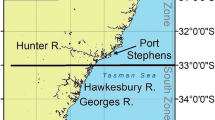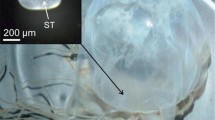Abstract.
Protocols used to collect and prepare otoliths for chemical analysis may result in either contamination or loss of elements, thus biasing population studies in unknown ways. We evaluated precision and bias associated with collection and cleaning procedures for three Atlantic tuna species: Atlantic bluefin tuna (Thunnus thynnus), yellowfin tuna (T. albacares), and blackfin tuna (T. atlanticus). Elemental concentrations were measured using solution-based inductively coupled plasma mass spectrometry and atomic absorption spectrophotometry. Seven elements were present above detection limits in all samples (Na, Mg, K, Ca, Mn, Sr, Ba). Mean concentrations of all seven elements were statistically indistinguishable in fresh pairs of otoliths of T. thynnus (mean error 5%, range 2–8%) and T. albacares (mean error 5%, range 3–7%); no indication of a left versus right otolith effect was observed. Otolith elemental concentrations were size dependent and significant inverse relationships were observed for Mg, Na, and K. Deliberate contamination of previously cleaned samples using a 10-ppm solution of a mixture of elements demonstrated that otoliths easily acquire surface contamination. Recleaning contaminated otoliths restored elemental concentrations to levels similar to control otoliths. Precision of paired comparisons between cleaned otoliths and those exposed to contamination and recleaned was high (mean error 6%). The effects of storage at two temperatures (7 days at –20°C, 3 days at 1°C) were investigated. For K, Ca, Sr, Mn, and Ba, variation between control (removed immediately) and treatment otoliths (in situ freezing or chilling) was similar to variation observed within fresh otolith pairs (mean error: fresh vs frozen 5%, fresh vs iced 5%). Statistically significant but small (<10%) postmortem storage effects were observed for Na and Mg. Estimates of error indexed to natural ranges in otolith chemistry of T. thynnus and T. albacares from different geographic regions in the Atlantic and Pacific showed that error values of several elements (Mg, Mn, Ba, Na, K) accounted for a small proportion of the natural range, suggesting levels of precision achieved in this study are suitable for the purpose of stock delineation.
Similar content being viewed by others
Author information
Authors and Affiliations
Additional information
Electronic Publication
Rights and permissions
About this article
Cite this article
Rooker, .J., Zdanowicz, .V. & Secor, .D. Chemistry of tuna otoliths: assessment of base composition and postmortem handling effects. Marine Biology 139, 35–43 (2001). https://doi.org/10.1007/s002270100568
Received:
Accepted:
Issue Date:
DOI: https://doi.org/10.1007/s002270100568




